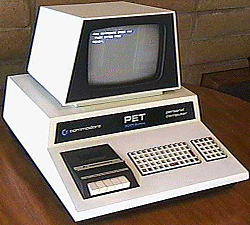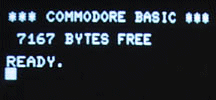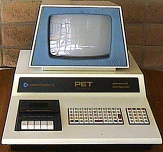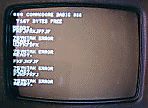




 The design of the Commodore PET 2001 was born from the mind and 6502
processor of Mr. Chuck Peddle, an engineer for the
former MOS Technologies. He was able to talk Commodore president
Jack Tramiel into giving
the home computer market a try. Tramiel agreed, and in 1977, Commodore
announced that the world's first fully-assembled home computer would
soon be available to consumers, though mail order was the only distribution
method in the initial months following its release.
The design of the Commodore PET 2001 was born from the mind and 6502
processor of Mr. Chuck Peddle, an engineer for the
former MOS Technologies. He was able to talk Commodore president
Jack Tramiel into giving
the home computer market a try. Tramiel agreed, and in 1977, Commodore
announced that the world's first fully-assembled home computer would
soon be available to consumers, though mail order was the only distribution
method in the initial months following its release.
"Computers for the masses, not the classes!" was Tramiel's cry, and as a result, the PET was not only powerful (for its time), but inexpensive. It comes with a built-in datasette, which accepts standard audio cassettes. It has a built-in 40 column monitor. It has an uppercase AND lowercase character set, AND a numeric keypad! To top it off, Commodore debut the greatest character set standard the world has ever known; PETSCII (as it is affectionately known) is a fully 8-bit character standard (ASCII/ANSI is only 7 bit) which includes alphabetic, numeric, mathematical symbols (including PI), cursor movements, screen control codes, and over 50 graphic symbols which can be accessed right from the keyboard!
 The best aspect of the PET, however, is its user operating environment:
Commodore BASIC. From the very beginning, using a Commodore
computer meant looking for your "READY" prompt, and entering commands like
"LOAD", "SAVE", and "RUN". The version of BASIC used by Commodore was
actually part of a perpetual licensing agreement with Microsoft. For almost
nothing, Commodore talked the young Bill Gates into licensing his
BASIC interpretor for use in Commodore computers. Commodore would continue
to use a highly modified and upgraded version of this interpretor in their 8-bit
computers to the very end, having never paid a cent in royalties to Microsoft.
The best aspect of the PET, however, is its user operating environment:
Commodore BASIC. From the very beginning, using a Commodore
computer meant looking for your "READY" prompt, and entering commands like
"LOAD", "SAVE", and "RUN". The version of BASIC used by Commodore was
actually part of a perpetual licensing agreement with Microsoft. For almost
nothing, Commodore talked the young Bill Gates into licensing his
BASIC interpretor for use in Commodore computers. Commodore would continue
to use a highly modified and upgraded version of this interpretor in their 8-bit
computers to the very end, having never paid a cent in royalties to Microsoft.
 The only downside of the 2001, however, has to be the keyboard construction. As seen in the
picture, the 2001 has very calculator-like keys that are hard to press.
This, of course, came from Commodore's (then) bread-and-butter calculator
business, but was soon corrected in later 2001 models. Cosmetically, these
machines vary by color of the monitor trim (blue and black), and by the
color of the stickers (again, blue and black). Here you see the two varieties
in this collection.
The only downside of the 2001, however, has to be the keyboard construction. As seen in the
picture, the 2001 has very calculator-like keys that are hard to press.
This, of course, came from Commodore's (then) bread-and-butter calculator
business, but was soon corrected in later 2001 models. Cosmetically, these
machines vary by color of the monitor trim (blue and black), and by the
color of the stickers (again, blue and black). Here you see the two varieties
in this collection.
 CPU: MOS 6502
CPU: MOS 6502
 Video: Discrete TTL
Video: Discrete TTL
Ports: MOS 6520 PIA, MOS 6522 VIA
 Keyboard: "Calculator" 69 key QWERTY
Keyboard: "Calculator" 69 key QWERTY
 Additional hardware: Datasette
Additional hardware: Datasette
Personal Note:
Having the original 2001 is a great collectors find, though it was tough
going. I've received very few that actually worked, despite having SIX
or so 320008 motherboards to pick from. Eventually, an
eBay auction provided a working model
for me. The 2001-4, however, came from the fabled George Page collection.
The built in cassette drive is very convenient, and is a feature
they should have kept in later models.
Click here to return to the main pictures page
If you find anything in here you have questions or comments about, feel
free to leave me email right here.
To return to my home page, click here.